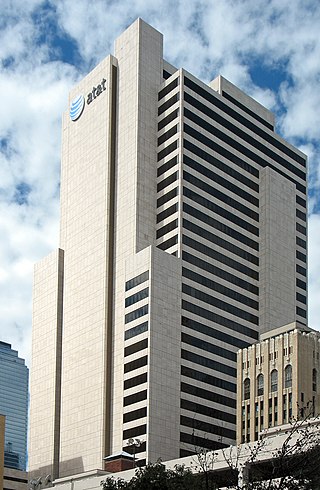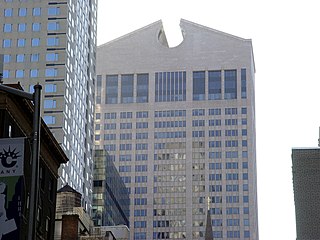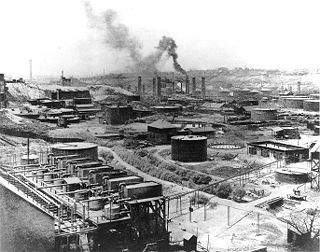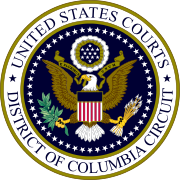Communications in the United States include extensive industries and distribution networks in print and telecommunication. The primary telecom regulator of communications in the United States is the Federal Communications Commission.
The Kingsbury Commitment is a 1913 out-of-court settlement of the United States government's antitrust challenge against the American Telephone and Telegraph Company (AT&T) for the company's then-growing vertical monopoly in the telecommunication industry. In return for the government's agreement not to pursue legal action against the company as a monopolist, AT&T agreed to divest the controlling interest it had acquired in the Western Union Telegraph Company, and to allow non-competing independent telephone companies to interconnect with the AT&T long-distance network.
In telecommunications, a customer-premises equipment or customer-provided equipment (CPE) is any terminal and associated equipment located at a subscriber's premises and connected with a carrier's telecommunication circuit at the demarcation point ("demarc"). The demarc is a point established in a building or complex to separate customer equipment from the equipment located in either the distribution infrastructure or central office of the communications service provider.

The Telecommunications Act of 1996 is a United States federal law enacted by the 104th United States Congress on January 3, 1996, and signed into law on February 8, 1996 by President Bill Clinton. It primarily amended Chapter 5 of Title 47 of the United States Code. The act was the first significant overhaul of United States telecommunications law in more than sixty years, amending the Communications Act of 1934, and represented a major change in that law, because it was the first time that the Internet was added to American regulation of broadcasting and telephony.

The telecommunications policy of the United States is a framework of law directed by government and the regulatory commissions, most notably the Federal Communications Commission (FCC). Two landmark acts prevail today, the Communications Act of 1934 and the Telecommunications Act of 1996. The latter was intended to revise the first act and specifically to foster competition in the telecommunications industry.

In telephony, the demarcation point is the point at which the public switched telephone network ends and connects with the customer's on-premises wiring. It is the dividing line which determines who is responsible for installation and maintenance of wiring and equipment—customer/subscriber, or telephone company/provider. The demarcation point varies between countries and has changed over time.
Universal service is an economic, legal and business term used mostly in regulated industries, referring to the practice of providing a baseline level of services to every resident of a country. An example of this concept is found in the US Telecommunications Act of 1996, whose goals are:
An incumbent local exchange carrier (ILEC) is a local telephone company which held the regional monopoly on landline service before the market was opened to competitive local exchange carriers, or the corporate successor of such a firm.

Mercury Communications was a national telephone company in the United Kingdom, formed in 1981 as a subsidiary of Cable & Wireless, to challenge the then-monopoly of British Telecom (BT). Although it proved only moderately successful at challenging BT's dominance, it led the way for new communication companies to attempt the same.
In telecommunications, interconnection is the physical linking of a carrier's network with equipment or facilities not belonging to that network. The term may refer to a connection between a carrier's facilities and the equipment belonging to its customer, or to a connection between two or more carriers.

The breakup of the Bell System was mandated on January 8, 1982, by a consent decree providing that AT&T Corporation would, as had been initially proposed by AT&T, relinquish control of the Bell Operating Companies, which had provided local telephone service in the United States. This effectively took the monopoly that was the Bell System and split it into entirely separate companies that would continue to provide telephone service. AT&T would continue to be a provider of long-distance service, while the now-independent Regional Bell Operating Companies (RBOCs), nicknamed the "Baby Bells", would provide local service, and would no longer be directly supplied with equipment from AT&T subsidiary Western Electric.
Baxter's law is a law of economics that describes how a monopoly in a regulated industry can extend into, and dominate, a non-regulated industry. It is named after law professor William Francis Baxter Jr., who was an antitrust law professor at Stanford University. As Assistant Attorney General, he settled a seven-year-old case against AT&T with by far the largest breakup in the history of the Sherman Antitrust Act, splitting AT&T up into seven regional phone companies in 1982.

AT&T Inc. is an American multinational telecommunications holding company headquartered at Whitacre Tower in Downtown Dallas, Texas. It is the world's fourth-largest telecommunications company by revenue and the largest wireless carrier in the United States. As of 2023, AT&T was ranked 13th on the Fortune 500 rankings of the largest United States corporations, with revenues of $120.7 billion.
After President Nixon took office in 1969, Clay T. Whitehead, Special Assistant to the President, pushed to establish an executive office dedicated to telecommunications policy. The White House Office of Telecommunications Policy (OTP) was established in 1970. In 1978, it was merged, along with the Commerce Department's Office of Telecommunications, into the newly created National Telecommunications and Information Administration (NTIA).

The Bell System was a system of telecommunication companies, led by the Bell Telephone Company and later by the American Telephone and Telegraph Company (AT&T), that dominated the telephone services industry in North America for over 100 years from its creation in 1877 until its antitrust breakup in 1983. The system of companies was often colloquially called Ma Bell, as it held a vertical monopoly over telecommunication products and services in most areas of the United States and Canada. At the time of the breakup of the Bell System in the early 1980s, it had assets of $150 billion and employed over one million people.

AT&T Corporation, commonly referred to as AT&T, an abbreviation for its former name, the American Telephone and Telegraph Company, is a subsidiary of AT&T that provides voice, video, data, and Internet telecommunications and professional services to businesses, consumers, and government agencies.
The history of AT&T dates back to the invention of the telephone. The Bell Telephone Company was established in 1877 by Alexander Graham Bell, who obtained the first US patent for the telephone, and his father-in-law, Gardiner Greene Hubbard. Bell and Hubbard also established American Telephone and Telegraph Company in 1885, which acquired the Bell Telephone Company and became the primary telephone company in the United States. This company maintained an effective monopoly on local telephone service in the United States until anti-trust regulators agreed to allow AT&T to retain Western Electric and enter general trades computer manufacture and sales in return for its offer to split the Bell System by divesting itself of ownership of the Bell Operating Companies in 1982.

The history of United States antitrust law is generally taken to begin with the Sherman Antitrust Act 1890, although some form of policy to regulate competition in the market economy has existed throughout the common law's history. Although "trust" had a technical legal meaning, the word was commonly used to denote big business, especially a large, growing manufacturing conglomerate of the sort that suddenly emerged in great numbers in the 1880s and 1890s. The Interstate Commerce Act of 1887 began a shift towards federal rather than state regulation of big business. It was followed by the Sherman Antitrust Act of 1890, the Clayton Antitrust Act and the Federal Trade Commission Act of 1914, the Robinson-Patman Act of 1936, and the Celler-Kefauver Act of 1950.

AT&T Corp. v. City of Portland, 216 F.3d 871, was a court ruling at the United States Court of Appeals for the Ninth Circuit. The ruling was an important early precedent on the regulation of local cable broadband networks, with the court finding that Federal Communications Commission regulations supersede those of local authorities.The ruling has also been cited as a precedent in network neutrality disputes.

United States v. AT&T, 916 F.3d 1029 (2019), was a ruling of the United States Court of Appeals for the District of Columbia Circuit, which prevented the U.S. government from blocking a merger between AT&T and Time Warner, thus creating the WarnerMedia conglomerate. The court found that regulators were unable to prove harm to consumers per the requirements of United States antitrust law.











